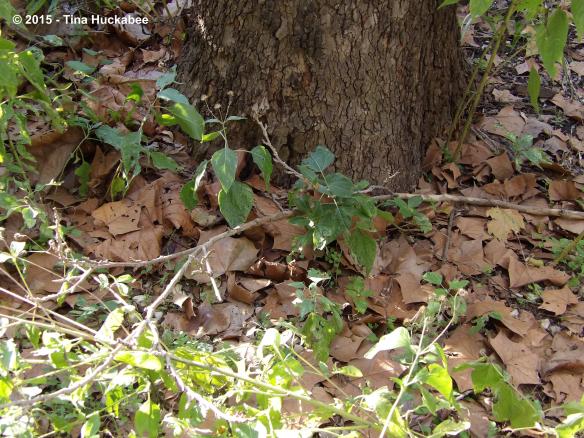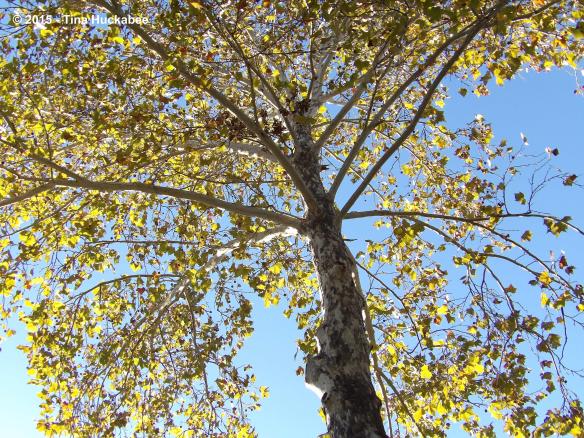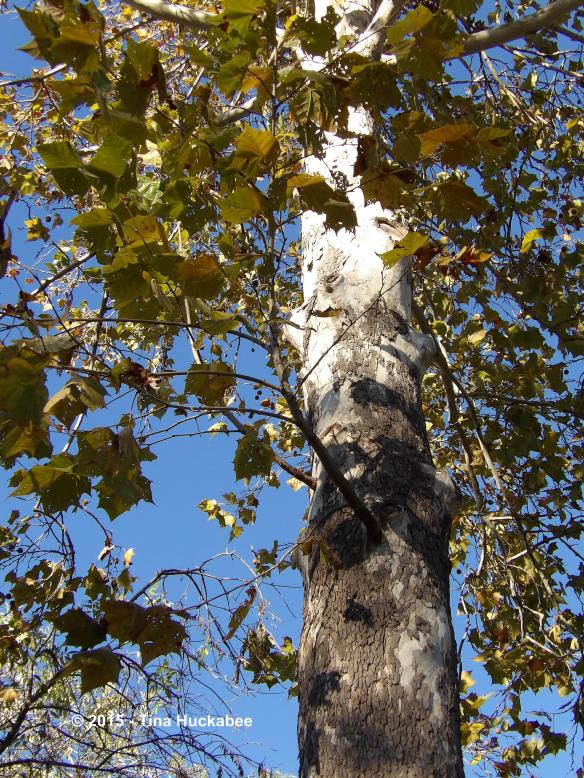Standing strong and upright, my tree to study for the remainder of 2015 and most of 2016 is the American Sycamore, Plantanus occidentalis.
Also known by the names Eastern Sycamore, American Plane Tree, Plane Tree, Buttonwood, and Buttonball Tree, I’m sure there are other namesakes, but I like the Lady Bird Johnson Wildflower Plant Database as a main reference when profiling native-to-North America plants and those are the names listed in the database on American Sycamore and I’ll stick with that list. Who am I to argue with the Lady Bird Johnson Wildflower Center??
I call my Sycamore Shed, which rhymes with Fred, but isn’t. As this post and the year with Shed progresses, you’ll understand why Shed is a good name for this tree.
A member of the Plantanaceae family, the Sycamore is deciduous and grows quite tall, upwards to 100 feet. I estimate that my Sycamore is about 55-60 feet tall. I might be off a few feet, because height estimation isn’t my best thing, but I’m in the ball park. It dwarfs my one-story 70’s urban home.
As a general rule, the Sycamore is considered a wetland plant and prefers more, rather than less, water. In nature you’d find this tree along stream and river banks, as well as in floodplains. So why is it planted at my house in arid Austin, Texas? Well, it is a native to this region, though we’re at its southwestern edge, and this region busts and booms with drought and flood. Though we are tending toward a drier climate in the last couple of decades, Sycamore trees are still commonly planted and mature specimens thrive. I wouldn’t choose to plant a Sycamore if I was in the market for a tree because it does prefer a wetter foot, but my tree was already established when we bought our home and I wouldn’t remove a healthy tree. It’s been a good tree for my garden: it provides shade in summer and in winter, reasons for me to complain when leaf clean-up commences. Additionally, it’s a great resting spot for birds,
…like this White-winged Dove.
What has it done this past month? It dropped some limbs, (remember the Shed moniker??), after strong winds from a cold front.
Actually, that last photo is of a limb that bludgeoned to the ground early in the summer and that I haven’t pruned and placed for the nice yard waste folks to remove. I like to keep some limbs around in my garden for the wood-nesting bees (and anything else that digs wood) and that large limb isn’t in the way, so I’ve left it alone. I frequently find very small limbs on the ground under this tree; here is one, with long-dead leaves attached, that has broken and is caught in the crook of larger branches, but has yet to fall.
Eventually, I’m sure that mess will end up on the ground for me to place in my yard waste bin.
After the bluster of wind with our first cold front, I found this along my front raised bed, which Shed overlooks and…sheds on.
These are the individual seed remains of some of the seed balls that are a signature feature of the American Sycamore.
It’s a little odd that some seed balls disseminated now, as it’s usually in spring that the Sycamore seed balls explode and spread their seedy selves, but it was a blustery wind.
Most of the seed balls dangle in the tree and haven’t yet busted apart and floated to terra firma –but they will. Eventually.
The foliage of my tree is just beginning its autumn color morph, which can be quite attractive, especially when viewing the total tree, as opposed to individual leaves.
American Sycamore’s leaves are large and thick–bright green in spring, summer, and early fall, turning a golden-yellow before they drop. They also can suffer some insect, disease, and heat problems depending upon the seasonal weather issues. Because of our heavy flooding in May and June, I think there was some damage to the foliage from either insects and a possible bout of Sycamore anthracnose, which is a troublesome, though not fatal, fungal disease of Sycamores. The current condition of many leaves, with some brown patches,
…and colored mottling,
…give me reason to think that during our very wet spring, the tree was under some assault and stress, though I must admit that I wasn’t paying much attention to the Sycamore at that time.
Ahem.
I rather like the splash of red on the leaves, but I can’t tell you if the coloration is normal.
Perhaps in a year’s time, when I’ve followed, watched, and learned, I can speak more knowledgeably about this tree.
Ahem.
The American Sycamore is a hardy tree, foliage quirks notwithstanding, and even when anthracnose is pervasive and a tree defoliates, the tree flushes out with new growth and continues its Sycamore leaf thing for the duration of the growing season.
Sycamore bark is beautiful,
…and the tree’s height makes a definitive statement in my garden.
It’s a tough survivor, which is one of the reasons I’m choosing to follow it and learn more about Shed, the American Sycamore. Many thanks to Pat at The Squirrelbasket for hosting Tree Following. Please pop over to her blog and learn what her tree and many others are up to for the December’s Tree Following.























I never saw a sycamore before moving here so I am still at the ‘oooh, how exotic stage.’ After hearing your description of their needs and habits it seems weird that so many places have decided to use them to line parking lots. hahaha That fad can only end in tears. The bark really is beautiful though: splashes of every hue of grey and white. And the seed ball looks a lot like a Christmas ornament.
I wonder if the dropping limbs are a sign of water stress. When we first moved in shortly before the worst of the drought we had HUGE limbs falling down froom the pecan trees — like tree sized. Everything has kind of stabilized but for awhile I really worried that they weren’t going to make it. The oldest ones predate the age of our housing development. We have a really old magnolia too — it is at least 120 years old. All these old wetland trees makes me wonder Austin was a much wetter place before we laid down all this concrete.
LikeLike
I think the sycamore is a tree worthy of lots of ‘ooohs’ and ‘aaahs’, but I would agree that it seems an odd choice given how hot and dry we tend to be now. But, you’re absolutely correct when you suggest that we’re hotter and drier than we used to be. Check out average historical temperature ranges and rainfall amounts and that’s a good guide. And for anyone who’s lived here more than 20 years? The changes are obvious. Concrete is only one of the problems contributing to our toastiness.
I think the sycamore is a “sheddy” tree, but I do agree that the dropping limbs are probably a result of drought conditions. Definitely in the summers, the sycamore sheds its leaves in response to drought. Pecans can also be rather weak limbed, but who doesn’t like those nuts!?!
LikeLike
Hotter and drier on the surface but I will just bet the water table of the soil has seen massive changes. Inspired by your post I’ve been reading up about the sycamore. I had no idea how long lived they can be! 500 years or more. That is mind boggling.
LikeLiked by 1 person
The leaves, fruits and bark of your American Sycamore are more like our non-native London Plane tree, not a bit like the non-native European Sycamore that has somehow been introduced here and is now a bit of a thug. Self sets itself in woodlands and gardens and is messy plus has less wildlife value than our native trees. As yours is a native, I expect its good for your wildlife. I wonder how the common name of American Sycamore came about?
LikeLike
I always forget that the term “sycamore” refers to a different tree in Europe than here in North America. I don’t know how the name sycamore came about–so far, I haven’t come across that in any research that I’ve done–which hasn’t been much, I have to admit. I know that the term “sycamore” is defined simply as “American plane tree” (by Merriam-Webster) and that the botanical term “plan” means flat, or flat-leafed, and “plantan” refers to the Plantanus, Plane Tree genus. Names are funny….
LikeLike
The seeds are so soft and fluffy. What a noble tree. I love the bark and the form and shape of your Sycamore. This meme is so fun because we not only learn about trees from around the world, but also their habitats and all the wildlife they support. 🙂
LikeLike
They are soft and fluffy–I’ve always liked them. In spring,you’ll see these feather wisps blowing in the in wind–quite pretty. I noticed the same in the strong wind that we had a few weeks ago and was a bit surprised. It’s a great tree for birds, though I don’t think any nest in it. More to come in the next year!
LikeLike
Apparently the common name “sycamore” comes from the Greek translation of the Bible, and there it referred to Ficus sycomorus, commonly called the sycamore fig or the fig-mulberry.
So there are several different trees we call sycamores today. As someone else mentioned, in Europe it’s a maple and in America it’s a plane tree.
I love the splashes of red on the leaves – hard to tell if they are something to do with mites or just patches losing their colour early for autumn?
I have never seen those fluffy seeds before – our plane trees here have balls as fruit but I never notice what happens to them after they fall.
May Shed’s shed branches remain small ones…
All the best 🙂
LikeLike
You’re absolutely right about the word and a little reading on my part would have found that out, but thanks for the lead. As for the red splotches, since I have never noticed it before, it’s hard to say if that’s common in fall. Usually the leaves are golden-to-brown as they change and drop, but the red is a nice touch. The seeds are really pretty, though I know folks who don’t like them.
LikeLike
I really like the Platanus bark, especially on very old specimens is fantastic. Not too often planted in home gardens because of the size, and in general I can tell that it’s a more common tree in Europe than in North America.
Just a mention about the seeds; they can be allergic to some people. As far as I know, people would wear masks when sowing in the nurseries.
LikeLike
Yes, I’d agree that it’s a bit too large for the average home garden, but nonetheless, there it is, in mine. 🙂 That’s really interesting about the seeds–I haven’t read that, but I’ll look into that information–should make a good post. Thanks!
LikeLike
The Sycamore does have exceptionally nice bark. I also like to keep fallen branches, stowing them in out of the way corners. Or if they look especially interesting, I lean them up against my Silver Maple, near Casimir the Concrete Chicken.
LikeLike
The bark is gorgeous and apparently used for flooring and furniture. I wish I was craftsy, as I imagine homemade wooden doo-dads would be quite lovely made with this wood. I love the name: Casimir!
LikeLiked by 1 person
Pingback: Tree following link box for December 2015 | The Squirrelbasket
I grew up playing under (and up in) a neighbor’s sycamore tree here in Austin. Sycamores were good climbing trees but we kids had to be careful not to climb past our comfort/safety zones. Seed balls sprayed gold in combination with lustrous magnolia leaves were what Ms. Stewart’s precursors swore by, an Austin holiday decor staple back in the day.
Things were different mumbledy years ago, the trees had it easy then by comparison. They didn’t need special attention. Now, as zone range edges shift, won’t it be useful to have these tree diaries as a referral source! You are all providing not only a fascinating deep look at each type of tree, but also a time capsule of what once thrived in each of your areas. Great stuff!
LikeLike
Played and climbed many-a-tree, but never a sycamore, unfortunately. Interesting about the crafty seed/leaf decorations. When I see sycamore seeds wafting in the wind, I think of the rare snowflake here in Austin. I’ve enjoyed this meme and the discipline in learning about a tree, up close and personal, for a year’s look.
LikeLike
Pingback: Tree Following in January: Big Dudes | My Gardener Says…